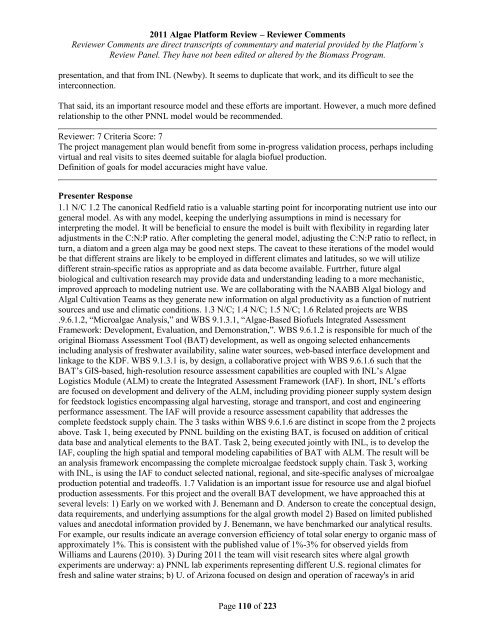Reviewer Comments - EERE
Reviewer Comments - EERE
Reviewer Comments - EERE
Create successful ePaper yourself
Turn your PDF publications into a flip-book with our unique Google optimized e-Paper software.
2011 Algae Platform Review – <strong>Reviewer</strong> <strong>Comments</strong><br />
<strong>Reviewer</strong> <strong>Comments</strong> are direct transcripts of commentary and material provided by the Platform’s<br />
Review Panel. They have not been edited or altered by the Biomass Program.<br />
presentation, and that from INL (Newby). It seems to duplicate that work, and its difficult to see the<br />
interconnection.<br />
That said, its an important resource model and these efforts are important. However, a much more defined<br />
relationship to the other PNNL model would be recommended.<br />
<strong>Reviewer</strong>: 7 Criteria Score: 7<br />
The project management plan would benefit from some in-progress validation process, perhaps including<br />
virtual and real visits to sites deemed suitable for alagla biofuel production.<br />
Definition of goals for model accuracies might have value.<br />
Presenter Response<br />
1.1 N/C 1.2 The canonical Redfield ratio is a valuable starting point for incorporating nutrient use into our<br />
general model. As with any model, keeping the underlying assumptions in mind is necessary for<br />
interpreting the model. It will be beneficial to ensure the model is built with flexibility in regarding later<br />
adjustments in the C:N:P ratio. After completing the general model, adjusting the C:N:P ratio to reflect, in<br />
turn, a diatom and a green alga may be good next steps. The caveat to these iterations of the model would<br />
be that different strains are likely to be employed in different climates and latitudes, so we will utilize<br />
different strain-specific ratios as appropriate and as data become available. Furtrher, future algal<br />
biological and cultivation research may provide data and understanding leading to a more mechanistic,<br />
improved approach to modeling nutrient use. We are collaborating with the NAABB Algal biology and<br />
Algal Cultivation Teams as they generate new information on algal productivity as a function of nutrient<br />
sources and use and climatic conditions. 1.3 N/C; 1.4 N/C; 1.5 N/C; 1.6 Related projects are WBS<br />
.9.6.1.2, “Microalgae Analysis,” and WBS 9.1.3.1, “Algae-Based Biofuels Integrated Assessment<br />
Framework: Development, Evaluation, and Demonstration,”. WBS 9.6.1.2 is responsible for much of the<br />
original Biomass Assessment Tool (BAT) development, as well as ongoing selected enhancements<br />
including analysis of freshwater availability, saline water sources, web-based interface development and<br />
linkage to the KDF. WBS 9.1.3.1 is, by design, a collaborative project with WBS 9.6.1.6 such that the<br />
BAT’s GIS-based, high-resolution resource assessment capabilities are coupled with INL’s Algae<br />
Logistics Module (ALM) to create the Integrated Assessment Framework (IAF). In short, INL’s efforts<br />
are focused on development and delivery of the ALM, including providing pioneer supply system design<br />
for feedstock logistics encompassing algal harvesting, storage and transport, and cost and engineering<br />
performance assessment. The IAF will provide a resource assessment capability that addresses the<br />
complete feedstock supply chain. The 3 tasks within WBS 9.6.1.6 are distinct in scope from the 2 projects<br />
above. Task 1, being executed by PNNL building on the existing BAT, is focused on addition of critical<br />
data base and analytical elements to the BAT. Task 2, being executed jointly with INL, is to develop the<br />
IAF, coupling the high spatial and temporal modeling capabilities of BAT with ALM. The result will be<br />
an analysis framework encompassing the complete microalgae feedstock supply chain. Task 3, working<br />
with INL, is using the IAF to conduct selected national, regional, and site-specific analyses of microalgae<br />
production potential and tradeoffs. 1.7 Validation is an important issue for resource use and algal biofuel<br />
production assessments. For this project and the overall BAT development, we have approached this at<br />
several levels: 1) Early on we worked with J. Benemann and D. Anderson to create the conceptual design,<br />
data requirements, and underlying assumptions for the algal growth model 2) Based on limited published<br />
values and anecdotal information provided by J. Benemann, we have benchmarked our analytical results.<br />
For example, our results indicate an average conversion efficiency of total solar energy to organic mass of<br />
approximately 1%. This is consistent with the published value of 1%-3% for observed yields from<br />
Williams and Laurens (2010). 3) During 2011 the team will visit research sites where algal growth<br />
experiments are underway: a) PNNL lab experiments representing different U.S. regional climates for<br />
fresh and saline water strains; b) U. of Arizona focused on design and operation of raceway's in arid<br />
Page 110 of 223




